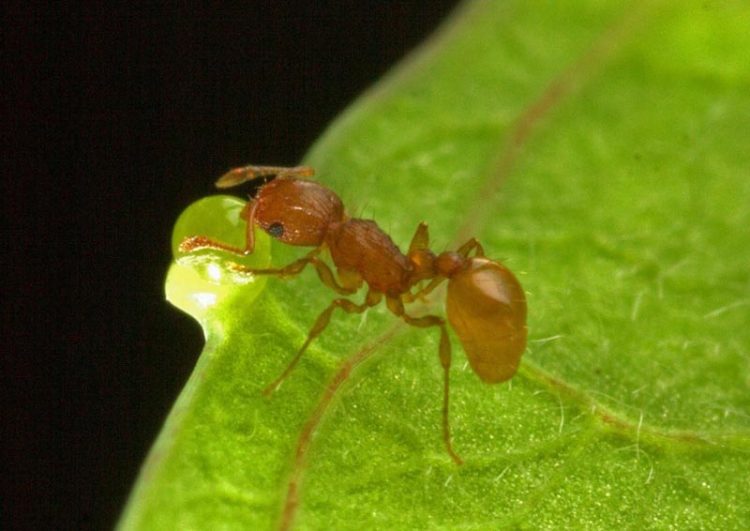Evolution puts checks on virgin births

A Little Fire Ant worker forages for food. All worker ants in this species are sterile females. Credit: OIST
Researchers at the at the Okinawa Institute of Science and Technology Graduate University (OIST) found that in species where females have evolved the ability to reproduce without males relatively recently, fertilization is still ensuring the survival of the maximum number of healthy offspring and thus males are still needed. The research was published online in The Science of Nature.
A species can increase its numbers faster in harsh environments when its females do not have to find worthy males. Scientists have further speculated that this ability arose independently in certain species, either due to conflict between the sexes or to ensure survival when mates were scarce. Many of these species now consist entirely of females.
The OIST Ecology and Evolution Unit has looked at the early evolutionary transition from sexual reproduction to clonal reproduction by studying a special case: the Little Fire Ant. It is a species in which certain populations reproduce sexually and others clonally, yet colonies in both types of populations still have males.
As in the case of other ant species, the males of this species fertilize queens to produce a worker class where all individuals are sterile, and accept genetic contributions from both parents. The peculiarity is in the offspring of the reproductive classes: fertile males hatch with no genetic contribution from the queen laying the egg, and new queens hatch without genetic contribution from the father.
The reason males still existed, and mating still occurred in a species where the male and female genetic information stays separate was a mystery, since the queens also have the genetic capacity to clonally produce both queens and workers.
The OIST researchers studied colonies from both sexually and clonally reproducing populations. They found that inseminated queens had close to a 100 percent success rate in terms of how many of their eggs hatched, whereas in case of queens that remain virgins, from both clonally and sexually reproducing populations, a majority of the eggs did not make it past early stages of embryo development. Mating also stimulated queens to lay eggs faster than not mating.
The OIST results indicate that in the Little Fire Ant case the battle of the sexes is unlikely. Mating with males enables queens to produce more healthy offspring than by cloning themselves. Sex also increases a queen's fitness as indicated by the enhanced egg laying and hatching success rates and as a consequence, the colony's fitness.
“In case of the whiptail lizard in the New Mexican desert which consists only of females, a type of pseudo-copulation still takes place before eggs start developing, suggesting evolution places certain checks on completely eliminating sex and sexual behavior,” said Prof. Alexander Mikheyev, head of OIST's Ecology and Evolution Unit, the paper's co-author.
The mechanism by which evolution prevents sex from being completely eliminated is yet to be determined. But what is clear is that even though certain species can bypass the need for sex to deal with challenging conditions, an evolutionary constraint seems to be wiring the females in these species to still expect the sexual stimulus. Without it, their reproductive systems just don't perform as well.
Media Contact
All latest news from the category: Life Sciences and Chemistry
Articles and reports from the Life Sciences and chemistry area deal with applied and basic research into modern biology, chemistry and human medicine.
Valuable information can be found on a range of life sciences fields including bacteriology, biochemistry, bionics, bioinformatics, biophysics, biotechnology, genetics, geobotany, human biology, marine biology, microbiology, molecular biology, cellular biology, zoology, bioinorganic chemistry, microchemistry and environmental chemistry.
Newest articles

First-of-its-kind study uses remote sensing to monitor plastic debris in rivers and lakes
Remote sensing creates a cost-effective solution to monitoring plastic pollution. A first-of-its-kind study from researchers at the University of Minnesota Twin Cities shows how remote sensing can help monitor and…

Laser-based artificial neuron mimics nerve cell functions at lightning speed
With a processing speed a billion times faster than nature, chip-based laser neuron could help advance AI tasks such as pattern recognition and sequence prediction. Researchers have developed a laser-based…

Optimising the processing of plastic waste
Just one look in the yellow bin reveals a colourful jumble of different types of plastic. However, the purer and more uniform plastic waste is, the easier it is to…



